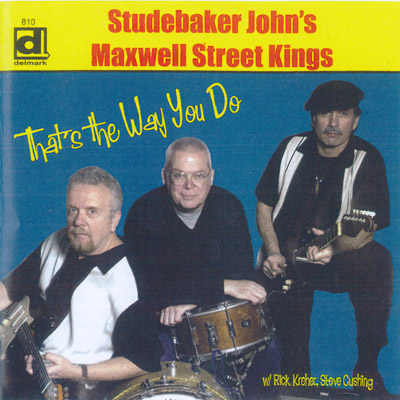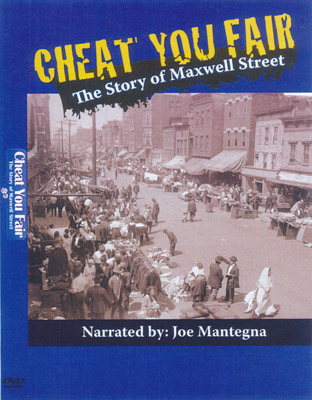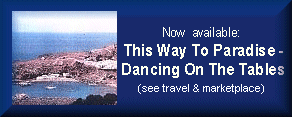Feature by Willard Manus
Some called it the "New Orleans of the North." Others referred to it as the "Ellis Island of the Midwest" or "the largest open-air flea market in the USA." Whatever its moniker, Maxwell Street was a colorful and fabulous place, a unique part of Chicago history that spanned two centuries before being stamped out by powerful real-estate and political forces.
Right after
the Great Chicago Fire in 1871 near-westside Maxwell Street became a haven
for both black and white folks, if only because its humble dwellings and
shops had been spared by the conflagration. At the end of the 19th century,
approximately 50,000 Jews fleeing European oppression flooded into the
neighborhood. They were followed by an even larger number of blacks escaping
from Southern racism and poverty. Seasoning the ethnic mix were numerous
German, Irish, Polish and Greek immigrants.

Maxwell Street became a melting pot for these disparate people. They blended
together in a microcosm of American democracy, living and working side
by side, enduring the Depression, WW II and other challenges in relatively
harmonious fashion. There were skirmishes and gang warfare (Al Capone
claimed Maxwell Street as his turf), but on the whole life in this densely
populated area was, as one denizen put it, "Pretty damn great. The
only color that mattered was green."
There were stores of all kinds here, with narrow doorways and large display windows that advertised dry goods, fresh produce, meats and fish, textiles and garments, jewelers and barbers. Restaurants, candy stores, pool rooms and pawn shops abounded; in many of their back rooms card and dice games took place, and bookies took bets on horse races and ballgames.
Every Saturday and Sunday from eleven to dusk a thousand-odd hawkers and peddlers set up their pushcarts and tables on both sides of Maxwell Street (which was eight blocks long). Everything and anything was for sale here--new and used clothing, electronic goods (some of it stolen), car parts, trinkets and junk of all kinds. Food-sellers offered a wide range of goodies as well--hot dogs with a kosher pickle in the bun, BBQ ribs, egg rolls, Polish sausage, chicken soup with matzo balls, Greek salads and pastries, etc.
You could also hear oodles of exciting music, thanks to the hundreds of blues artists who set up all along "the stem," playing not just for money but to practice their craft and learn from each other.
"You
could make more money with three or four guys than you could make in a
club the whole week," said guitarist Jimmy Rogers, who lived just
off Maxwell Street (known locally as "Jewtown").

Rogers and such other musicians as Buddy Guy, Muddy Waters, Bo Diddley and Little Walter perfected what became known as the Chicago electric blues sound--a sound that brought them fame and was later emulated by rock pioneers like The Rolling Stones, Led Zeppelin and Eric Clapton. Maxwell Street was also home to many others who achieved fame in non-musical fields: Barney Balaban (motion pictures), William Paley (CBS), Barney Ross (boxing) and Hyman Rickover (Navy admiral).
The whole story of the rise and fall of Maxwell Street is told in a remarkable DVD: CHEAT YOU FAIR--THE STORY OF MAXWELL STREET. Written and produced by Phil Ranstrom, narrated by Joe Mantegna, the 90-minute documentary mixes historical and contemporary film footage, interviews and reportage in skilful fashion, making for fascinating and informative viewing. CHEAT YOU FAIR (the title comes from an infamous Maxwell Street shop sign) also has a redhot blues soundtrack. Visit cheatyoufairthemovie.com.
Another tribute to Maxwell Street (which, by the way, was levelled in 1994 by the city of Chicago and the University of Illinois to make way for dormitories and gentrification) has been put together by three contemporary Chicago blues musicians: Studebaker John (vocals, slide guitar, harp); Rick Kreher (guitar, vocals); and Steve Cushing (drums). Calling themselves the Maxwell Street Kings, their new CD That's the Way You Do is dedicated to "all musicians who played on Maxwell Street, especially Big John Wrencher, Johnny Young, Robert Nighthawk and Carey Bell." The fifteen original tunes on the CD pay homage to the eternal spirit and legacy of Maxwell Street. (Delmark Records; delmark.com)
Finally, a new play called MAXWELL STREET, will have its world premiere in Los Angeles April 15-May 1 at the Barbara Morrison Performing Arts Center. Written by Willard Manus and directed by Keenan Zeno, the new play pays tribute to the glory days of 60s blues boom in Chicago. MAXWELL STREET focuses on the relationship between a venerable black bluesman, Snooks Lawson, and a hotshot, young white kid who not only idolizes him but wants to team up with him and break down the walls of segregation--and change the very look and sound of the blues.
The Barbara Morrison Performing Arts Center is located at 4305 Degnan Blvd. (corner of Crenshaw & 43rd St. in the Leimert Park district of Los Angeles). For tickets and information, call 213-909-3791 or visit keenan@caketheatrecenter.com
